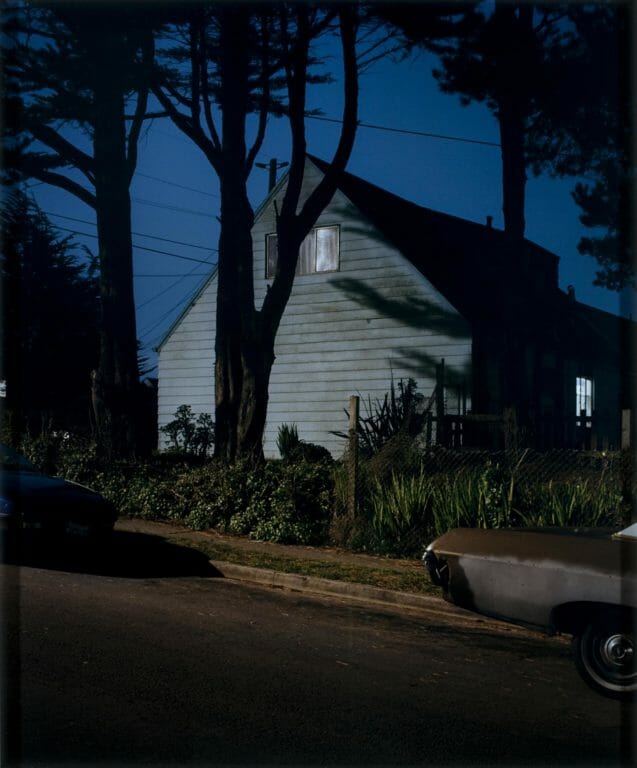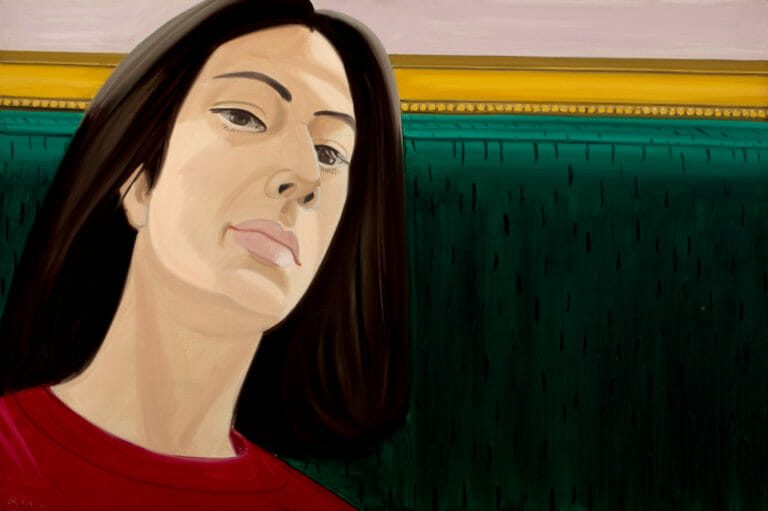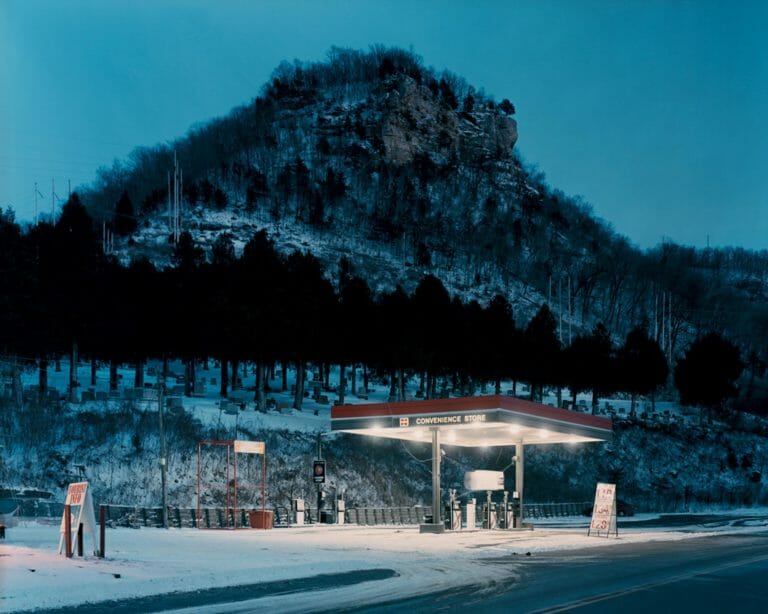Teaching Pages
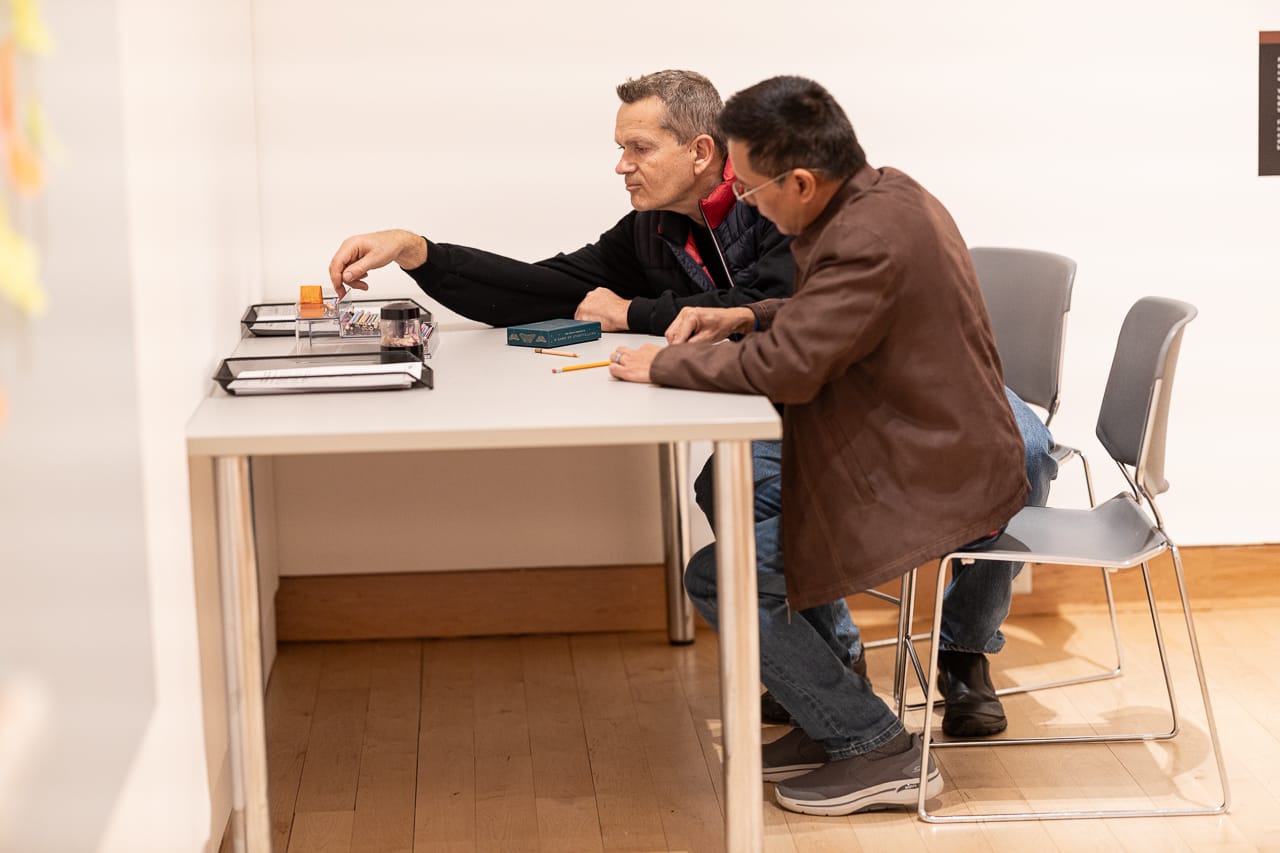
About Teaching Pages
Teaching pages provide analysis of a selection of works of art on view at the Museum, biographical information on featured artists, discussion questions, and links to additional resources. Teaching pages are prepared by MMoCA’s education department as an introduction to a museum visit by school groups.
On View Now
The large sculpture Depression Bread Line by George Segal portrays the experience of many urban Americans who suffered from hunger during the 1930s Great Depression. During this difficult period, which affected the whole world, economies faltered in both industrialized and non-industrialized countries.
Permanent Collection
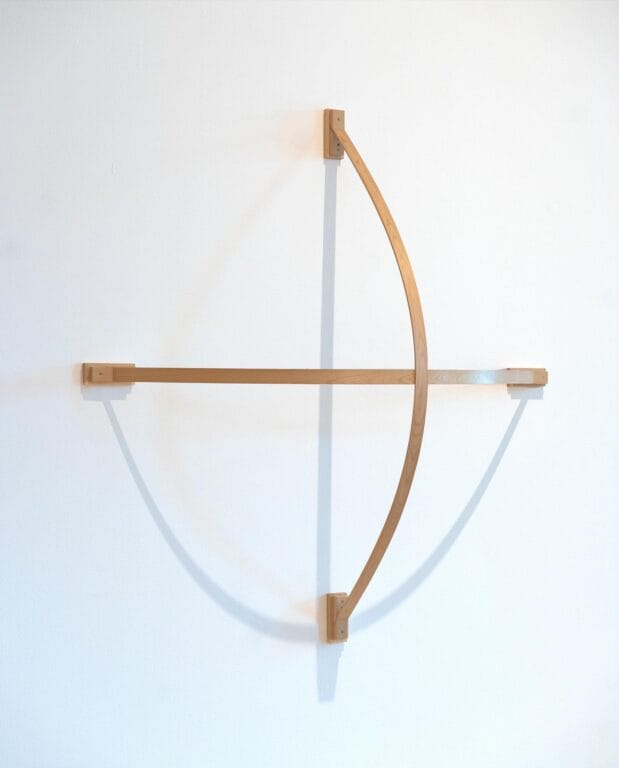 Truman Lowe
Truman Lowe
Thunder Bay II is a wall-mounted sculpture made from wood that features curved wooden slats that cross as a central point. Truman Lowe’s wooden sculptures are influenced by the traditional methods of splint-plait basket-making of the Black River Falls Ho-Chunk community.
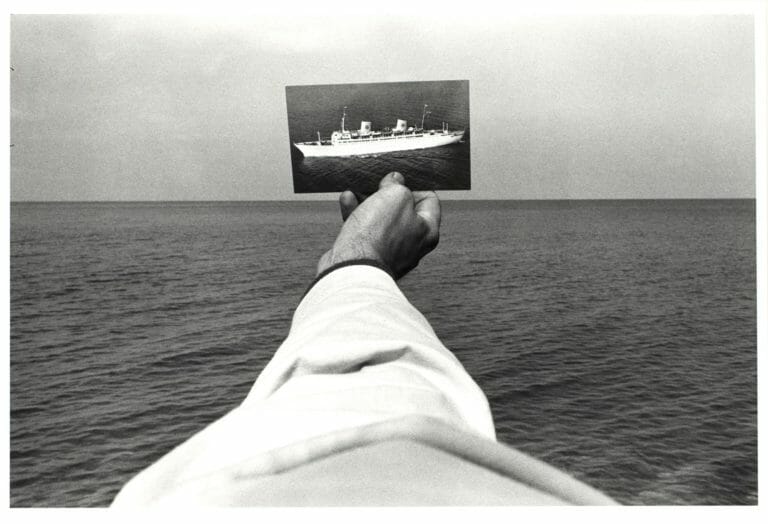 Kenneth Josephson
Kenneth Josephson
New York State, 1970 seems to be an amusing portrayal of “reality,” since a real arm is holding a picture of a real boat against the horizon line in a position mimicking the place a ship would really float. The arm stretched over water calls forth confidence that an actual person is reaching over a railing on the edge of land or on a boat. Black, white, and gray color values and the rectangular shape of the images are elements that tap into viewers’ familiarity with photographs.
 Leopoldo Méndez
Leopoldo Méndez
This relief print, created as a backdrop for the opening and closing credits of the 1947 Mexican film Río Escondido, portrays the singular determination of a young school teacher. She walks alone carrying a valise across a stark landscape, appearing diminutive under a sky filled with symbolic shapes that seem to be her guides. The wings of an eagle offer safeguard, and an angel-like figure aims a finger and a flagstaff in the direction she is heading.
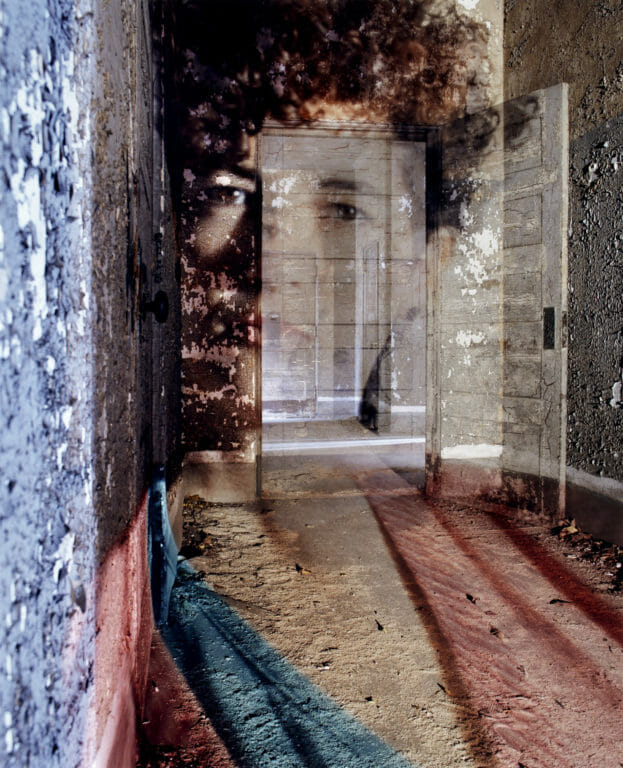 Lorie Novak
Lorie Novak
This ghostly photograph by Lorie Novak is named Self Portrait (Ellis Island), an unusual juxtaposition of words for a title. The title suggests that the face in the center is that of the artist herself; however, it also implies that the picture is something of a self-portrait of the famous port of entry for immigrants coming to America. Ellis Island is a small island in New York Harbor, close to New York City and near the Statue of Liberty.
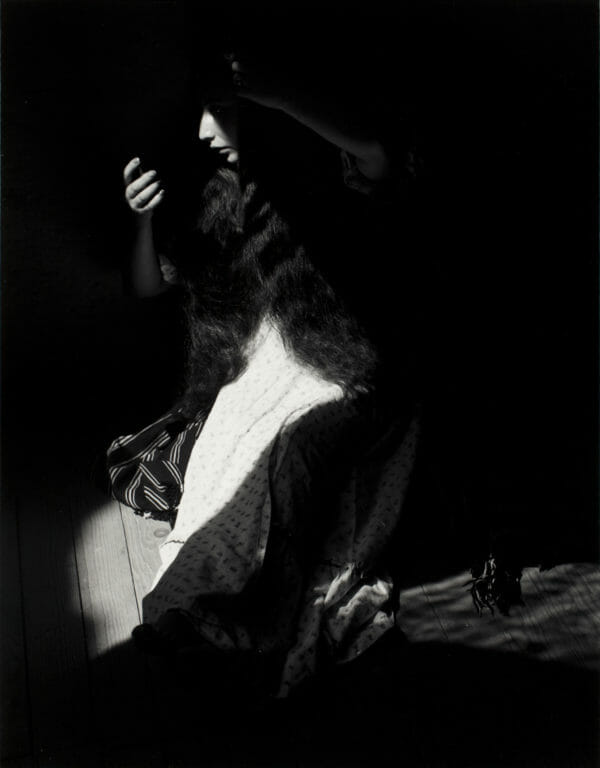 Manuel Álvarez Bravo
Manuel Álvarez Bravo
Lush contrasts of dark and light draw the viewer close to this timeless scene of a woman gazing into a mirror. Her eyes are obscured by a long shadow falling over her from forehead to hip. The shadow covers part of her wavy mane of hair, which she draws back with her left hand.
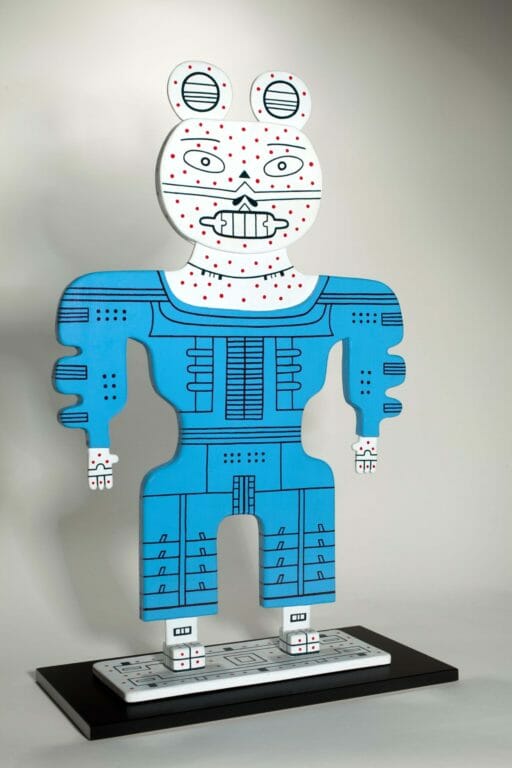 Karl Wirsum
Karl Wirsum
This little wood figure has red spots on his face, neck, hands, feet, and on his round mouse ears. Even though Measle Mouse is small―just two feet tall―he has powerful-looking shoulders and is wearing an impressive blue outfit as if suited up for a sport or a performance or an important task.
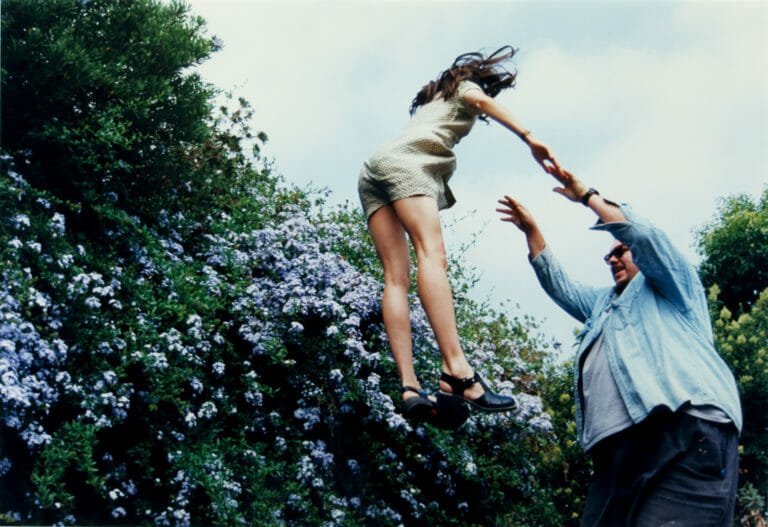 Martin Kersels
Martin Kersels
In each photograph in Tossing a Friend (Melinda) (1, 2, and 3), one sees a petite woman in a summer dress being thrown through the air by a large man. Upon closer inspection, we notice that each photograph has been taken from a different vantage point. The three photographs are hung vertically on the gallery wall, making the difference in camera angle and height of each toss more discernible.
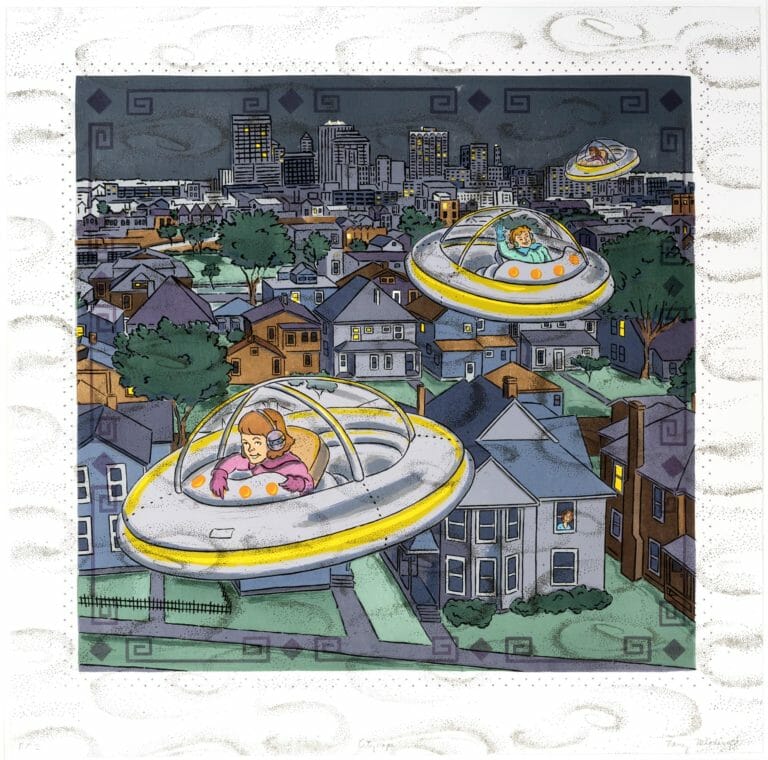 Nancy Mladenoff
Nancy Mladenoff
Moonlight falls on the rooftops and lawns of a suburban neighborhood, adjacent to an urban center. Most of the residents appear to be asleep, and noisy cars and voices seem absent, although a few lighted windows suggest that some inhabitants are still awake.
 Juan Sánchez
Juan Sánchez
Juan Sánchez photographed this “moment in the street” when his friends’ children paused with their flowers and bicycle. The girls in front are smiling openly; the taller girl in back looks solemn and somewhat protective with her hands on the others’ shoulders.
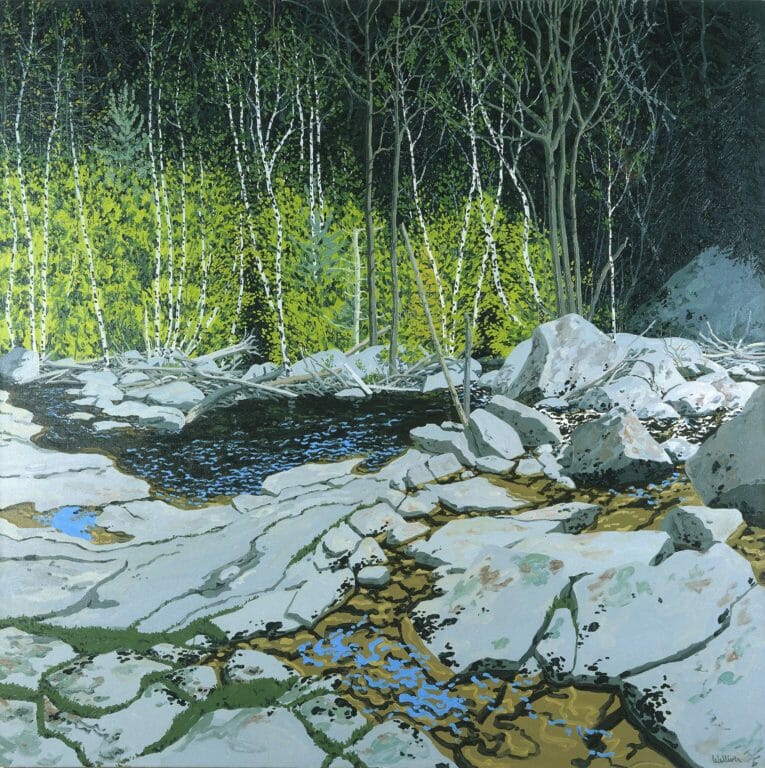 Neil Welliver
Neil Welliver
Water courses through a clearing in a lush forest of birch and evergreen trees. A bright, clear day in summer is suggested by the strong contrast between light and dark—the woods in the background are nearly black while the chartreuse-colored trees and gray rocks are illuminated as if by the strong sun of a high mountain plateau.
 Paul Shambroom
Paul Shambroom
Paul Shambroom’s panoramic photograph has the appearance of a seventeenth-century Dutch painting of civic leaders. It is large, thirty-three inches high and sixty-six inches wide. Flags and maps suggest that the photograph was taken in a government meeting.
 Philip Hanson
Philip Hanson
Philip Hanson’s Mezzanine beckons us into a richly colored architectural space while simultaneously preventing us from knowing where the space leads or what lies at the end of its passageways.
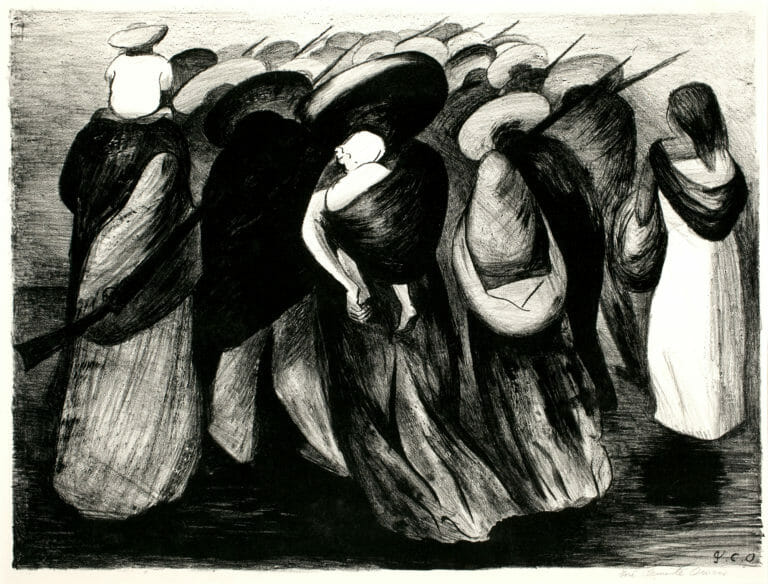 José Clemente Orozco
José Clemente Orozco
José Clemente Orozco created La retaguardia, or The Rear Guard, in 1929. Though Orozco painted many murals, he was also a renowned printmaker. The Rear Guard is a black-and-white print created using lithography, a printmaking method that uses limestone blocks or aluminum plates to transfer ink drawings to a sheet of paper.
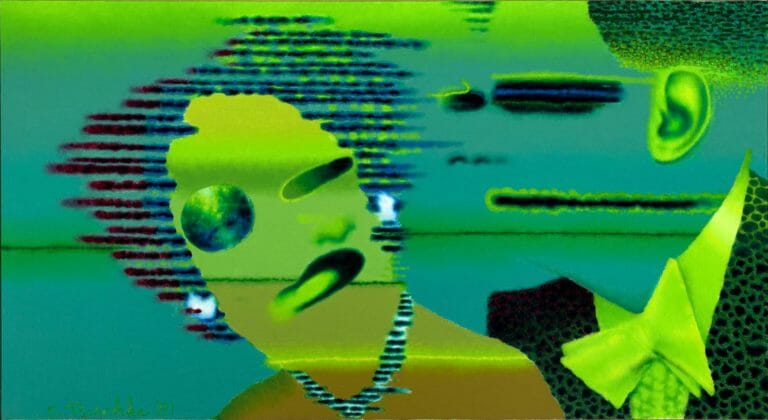 Ed Paschke
Ed Paschke
With their electrifying greens, yellows, reds, and blues, La Chanteuse and Prothesian have the glow of a TV screen in a darkened room. Strong horizontal lines radiate color and create an effect of electronic interference.
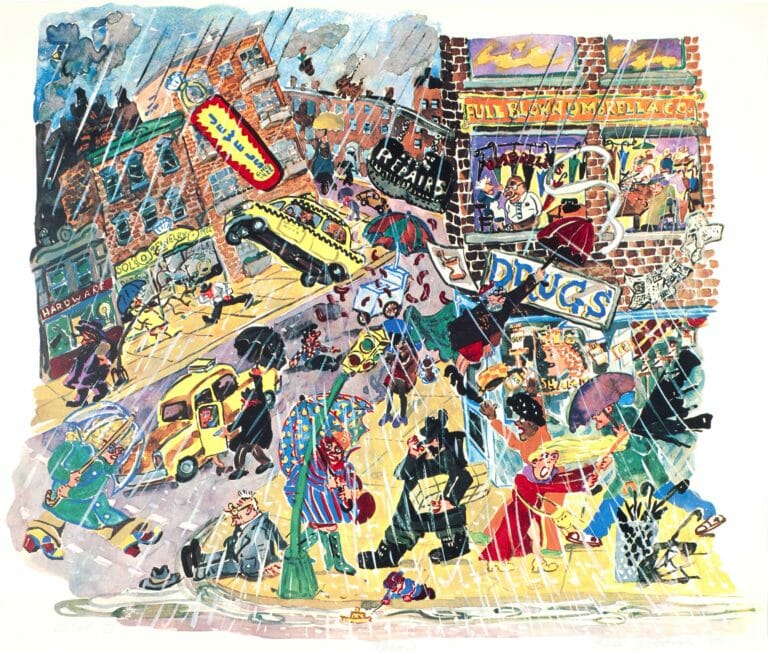 Red Grooms
Red Grooms
A heavy rainstorm is swooping through a colorful intersection of stores and apartments, streets and sidewalks. Like a typical big city corner, this one is jam-packed with shoppers, workers, and vehicles.
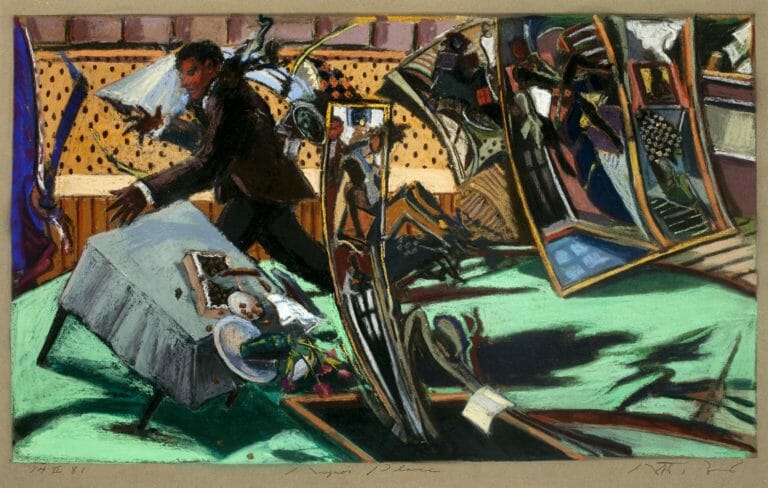 Robert Barnes
Robert Barnes
Unraveling Robert Barnes’ paintings, such as Ragno’s Place, is an exercise in sorting out how we arrive at “reality.” Even though his paintings are usually figurative and seem to tell a story, their stories are enigmatic and often steeped in obscure references to literature, poetry, or other artists’ works.
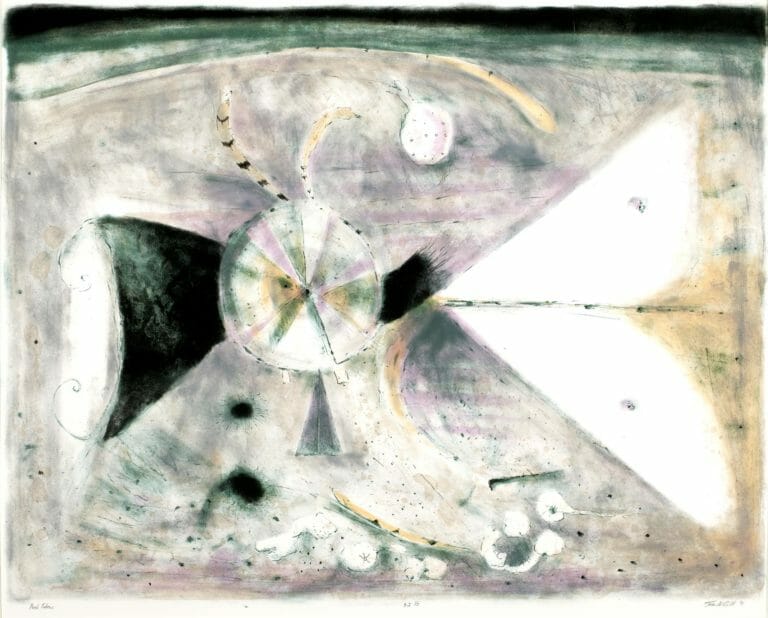 John Colt
John Colt
The “pond tokens” in this lithograph are treasures the artist has discerned from close looking at a watery scene. John Colt was not interested in exploring large vistas; rather, he said he liked the “little areas—little realms of experience, nature close up,” and his title for this work demonstrates that he liked to look at what most represented, or was a token, of one of these sites.
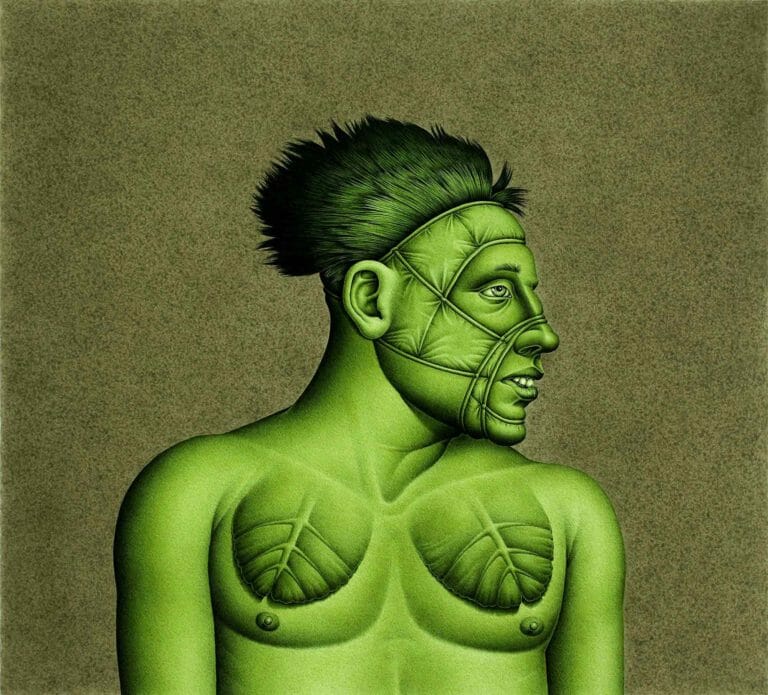 Robert Lostutter
Robert Lostutter
Trader of Green is an unusual portrait. Even though its format is a traditional close-up view of a figure shown from the front and with his head turned to the side, there are surprises.
 Warrington Colescott
Warrington Colescott
There’s a pun in the title The Future: On the Line. Assembly line workers are building vehicles of the future, but their appearance, their functions, and their environment suggest that work life is “on the line” or on the brink of worrisome change, where humans are subservient to robots who supplant them in performing industrial tasks.
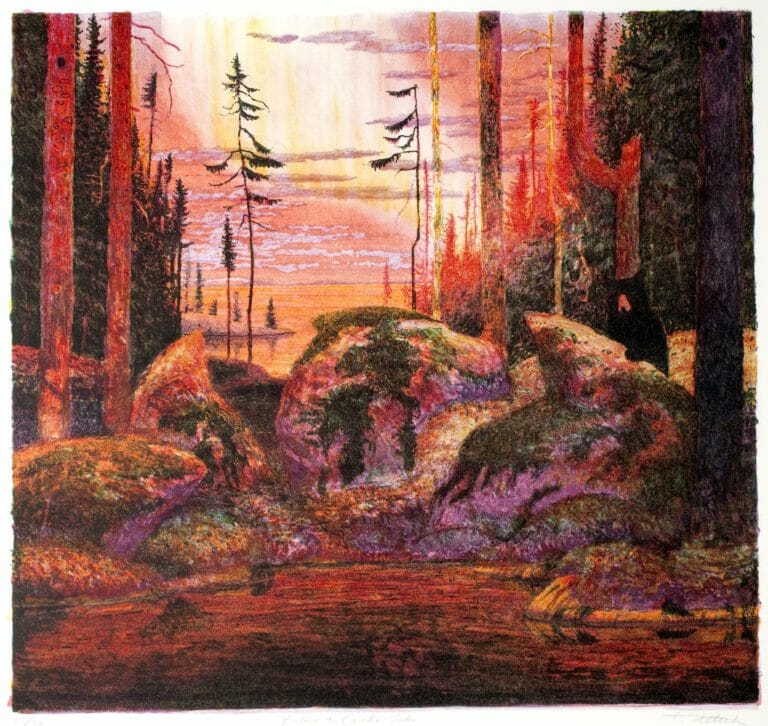 Tom Uttech
Tom Uttech
Changing daylight illuminates a vibrant scene of lake and forest in the American North. Spindly pine trees and moss-covered boulders fill a narrow strip of land between a watery shoreline in front and a lake behind.
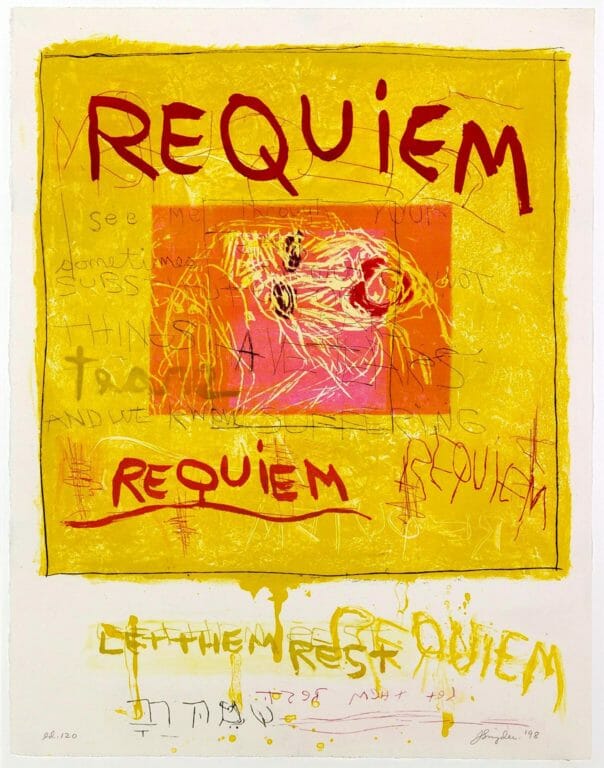 Joan Snyder
Joan Snyder
Requiem/Let Them Rest by Joan Snyder is an arresting mix of color and text. If a person were to walk by this image tagged on a wall full of graffiti, the jarring hues and the blaring word Requiem might call for a closer look.
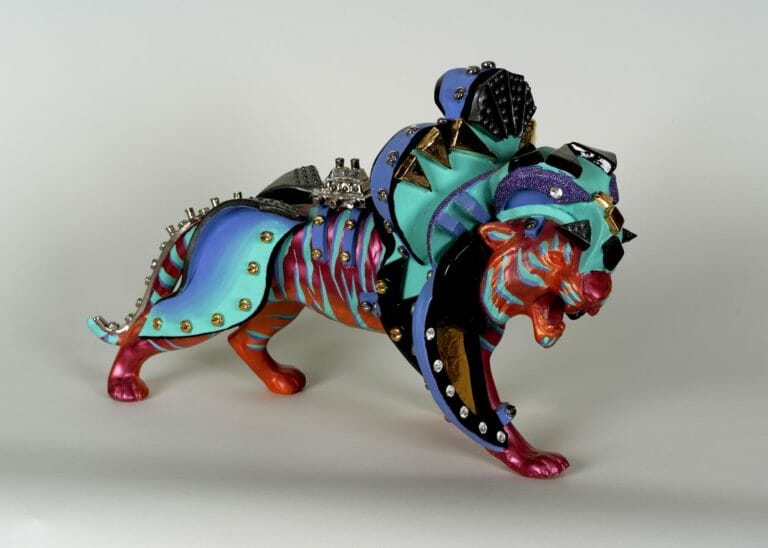 Toby Buonagurio
Toby Buonagurio
A tangerine colored tiger strides forward, its mouth open in a roar, baring its teeth. Its stripes and the body armor covering its legs and shoulders are turquoise, shaded with blue. Glitter highlights a tall headdress decorated with rhinestones, gold triangles, sliver studs, and a black crest.
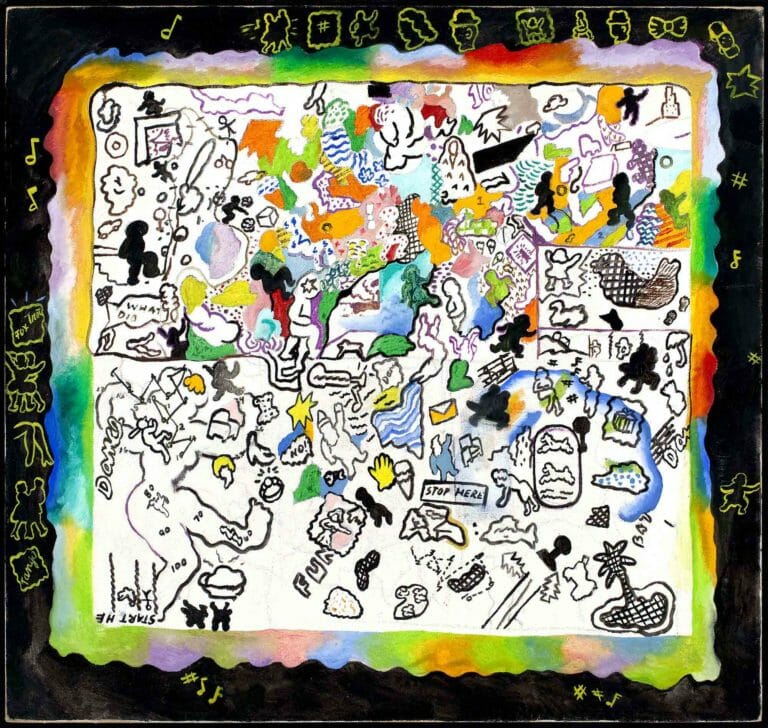 Suellen Rocca
Suellen Rocca
Surrounded by a black margin, on what seems like a collaged sheet of paper painted with watercolors, is a colorful game board actually painted with thinned oils on canvas. Clues to the game are painted on the margin, including music notes and dancing couples, as well as little framed words naming dance steps—fox trot and tango.
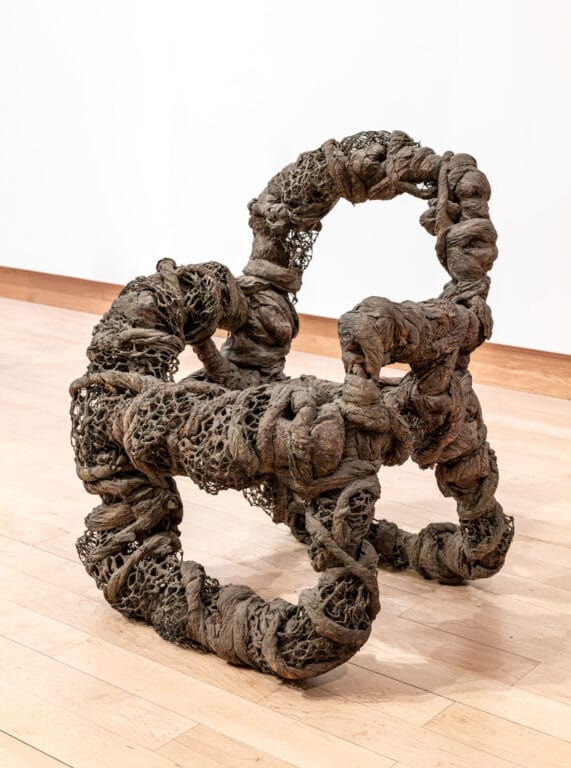 Jin Soo Kim
Jin Soo Kim
Only three feet tall, untitled, C.H.F. is a bulbous little chair whose underlying metal frame is wrapped with thick skeins of tightly knotted brown paper twisted around encircling segments of chicken wire. The ropy paper skeins twine along the chair skeleton with organic energy, like vines enveloping a tree trunk, highlighting and distorting the geometry of the angular lawn chair.
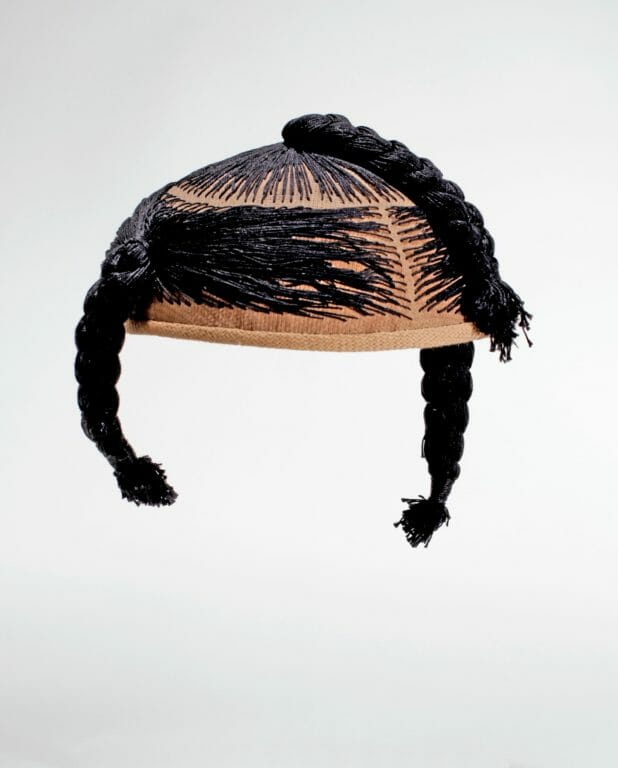 Sonya Y. Clark
Sonya Y. Clark
Is this object made from real hair? Is it a hat? Is it part of a costume? Who might wear it? Since it is three-dimensional and is located in an art museum, is it a sculpture?
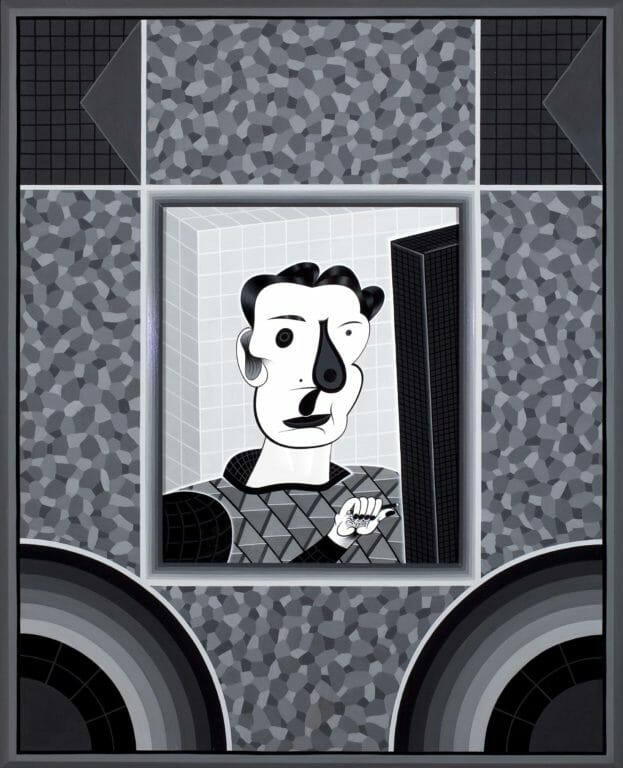 Jim Nutt
Jim Nutt
Some kind of trouble may have happened to someone named Jim. One of his eyes is black and larger than the other. His nose looks swollen. Questions arise. How did Jim get this black eye? Was Jim picked on, or has he picked on someone else and started a fight? Was the conflict really necessary or could it have been avoided?
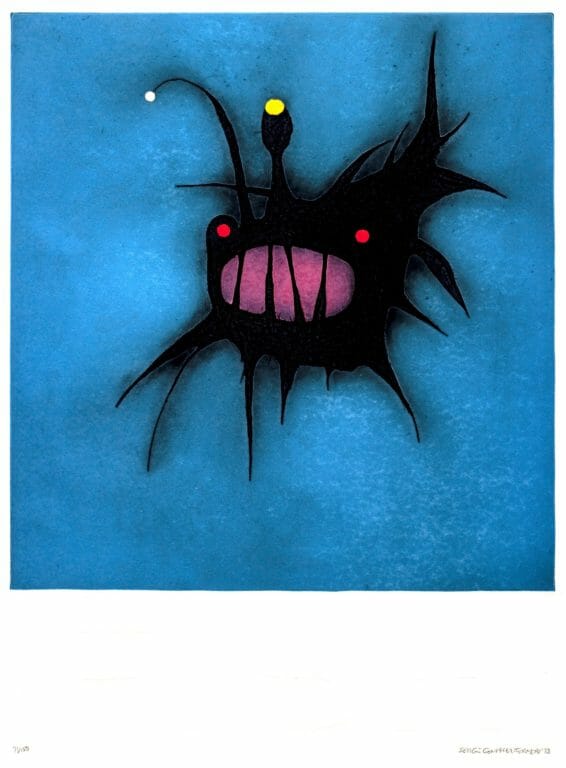 Sergio Gonzalez-Tornero
Sergio Gonzalez-Tornero
Sergio Gonzalez-Tornero has created a haunting image of an extraordinary fish as it floats in the depths of the sea. The fish appears to glow from within, with its red eyes, pink mouth, and yellow- and white-tipped appendages.
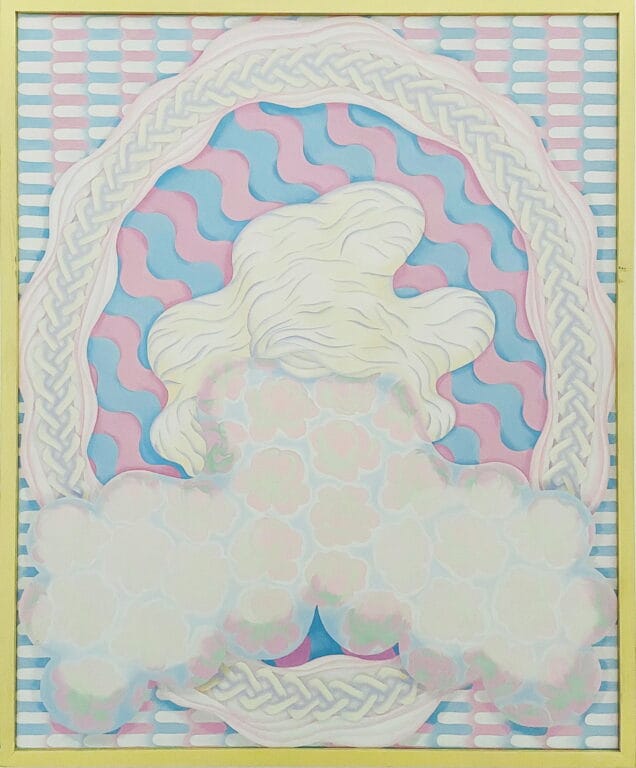 Sarah Canright
Sarah Canright
Sarah Canright’s painting Shadow can be read as three layers of precise patterning in ghostlike tones of blue, pink, purple, white, and green. The tightly composed background features interlocking geometric prongs that fit together like puzzle pieces, a chain-link fence, or woven textile.
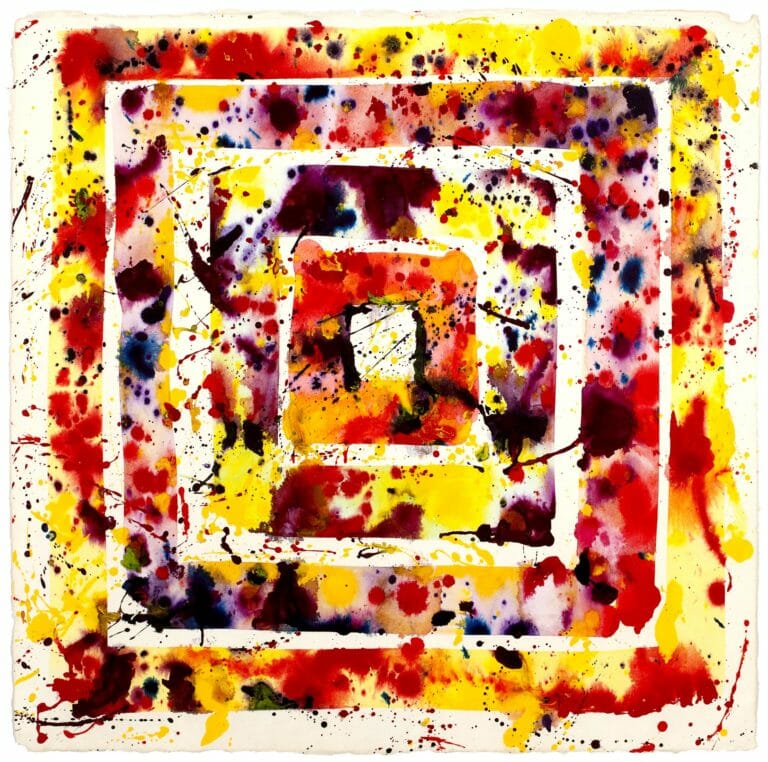 Sam Francis
Sam Francis
Radiating from a white center, four concentric squares of bright color glow from the surface of a large square sheet of white paper. Yellow, red, and blue puddles merge in hues of purple and orange.
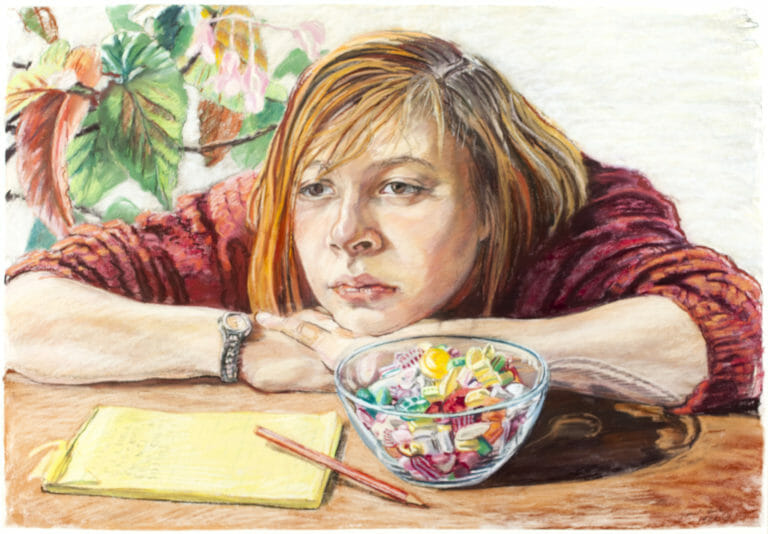 Janet Fish
Janet Fish
Janet Fish presents one of these moments in her pastel Sasha with a Bowl of Candy. An adolescent girl hunches over a wooden surface, perhaps a table or a desk, her forearms spread across the surface from nearly one side of the composition to the other, her chin resting on the back of overlapped hands.
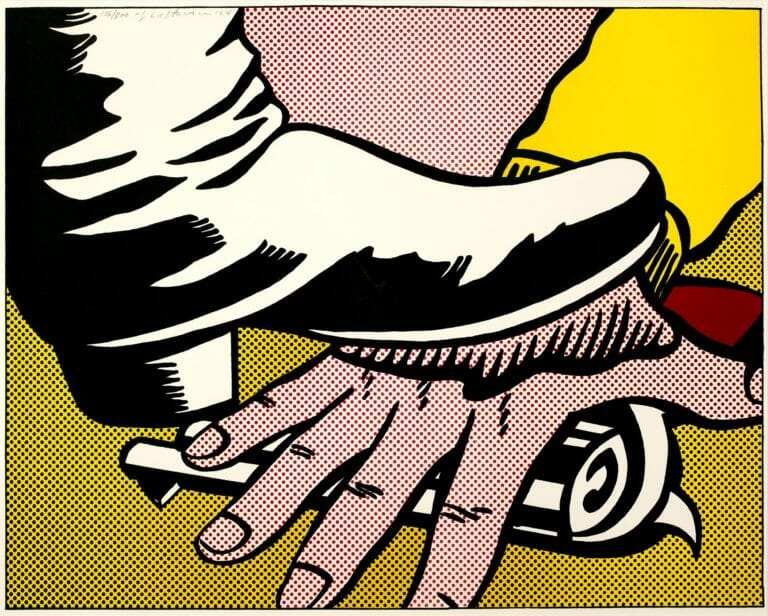 Roy Lichtenstein
Roy Lichtenstein
Is the foot wearing a cowboy boot or a dress boot? Does the foot belong to a woman or man? Does the hand belong to a teenager or adult? In whose possession was the gun moments before? Which person is being threatened? Would an innocent observer be glad the foot blocked the hand, or not? What is going on here?
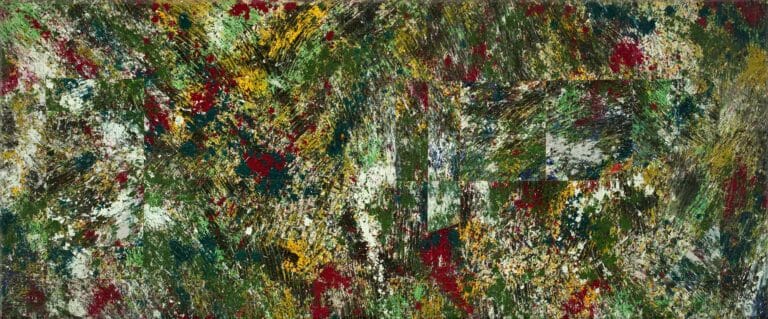 Sam Gilliam – Irish Spring Here
Sam Gilliam – Irish Spring Here
Irish Spring Here, created in 1980, is one of many heavily textured, geometric collage paintings that Sam Gilliam began creating in the mid 1970s. By this time Gilliam had already received positive critical reception for his draped and suspended paintings.
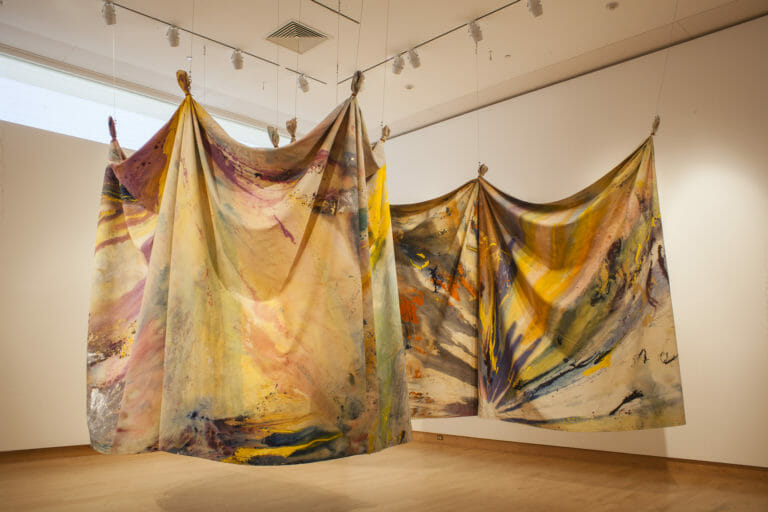 Sam Gilliam – Carousel
Sam Gilliam – Carousel
Carousel, a colorful, sixty-seven-foot-long, draped canvas, hangs suspended from the ceiling. Sam Gilliam was consulted about the arrangement of Carousel; however, he does not have strict rules for the way his draped paintings are to be installed. Instead, he prefers the work to be recomposed each time it is exhibited.
 Jane Hammond
Jane Hammond
Jane Hammond’s painting Irregular Plural II inspires a complex “reading.” The canvas, shaped like an enormous book with scalloped end sheets and gilt edging, is filled with colorful images that hint at a multitude of stories.
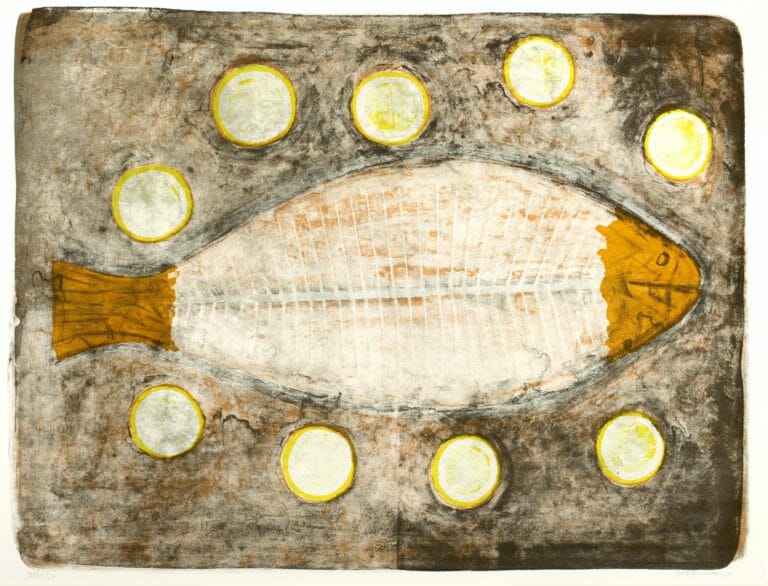 Rufino Tamayo
Rufino Tamayo
An ordinary meal of fish, offered with lemons for their citrus seasoning, takes on significance and dream-like mystery in this lithographic print by Rufino Tamayo, an artist also known for his murals and paintings.
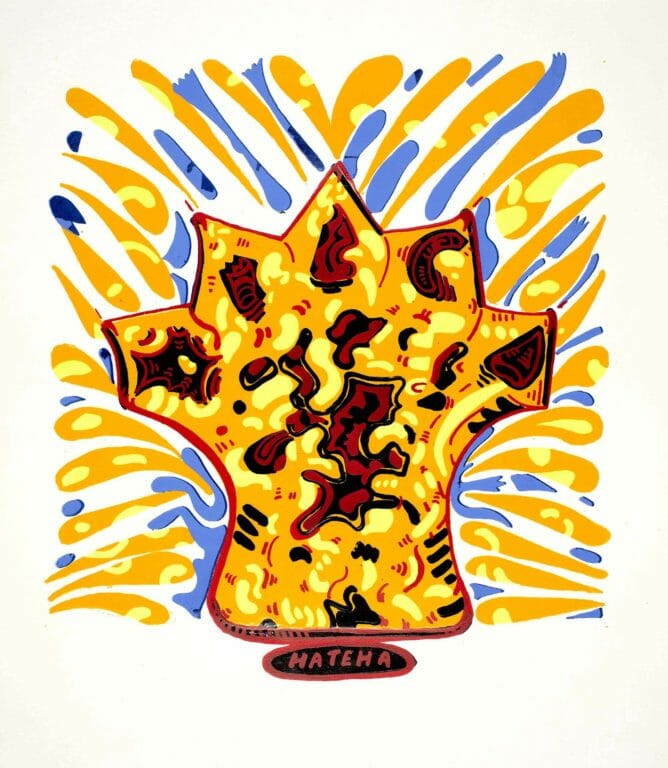 James Falconer
James Falconer
Thick swathes of blue, orange, yellow, red, and black burst forth in James Falconer’s Hateha. Streaks of orange with yellow highlights and blue with thin black outlines explode like fireworks from behind the unfamiliar central shape.
 Romare Bearden – Serenade
Romare Bearden – Serenade
Serenade depicts an intimate moment between two people. They face each other and gaze into one another’s eyes. Their hands come together on the guitar. Their bodies merge. The candle and cup tell us something about the occasion.
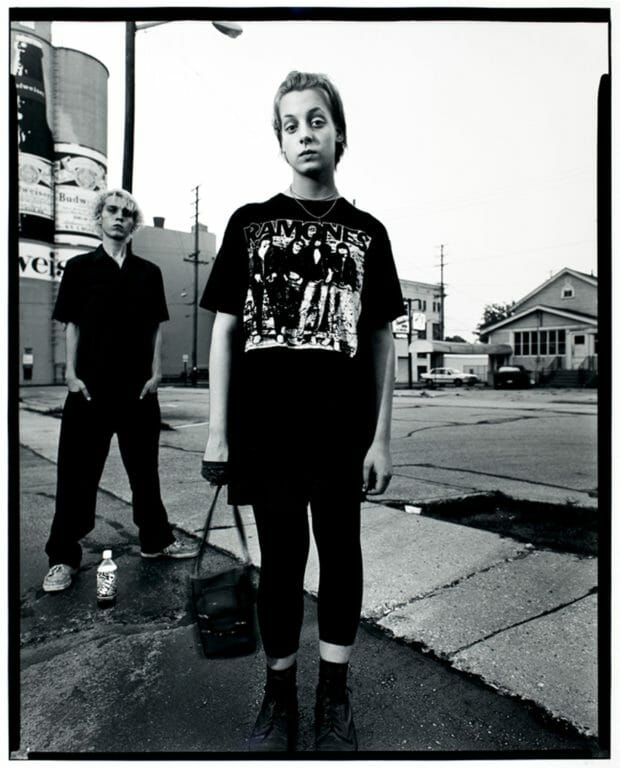 J. Shimon & J. Lindemann
J. Shimon & J. Lindemann
In John Shimon and Julie Lindemann’s black-and-white photograph, a young man and woman pose for a photograph captured using techniques from the past.
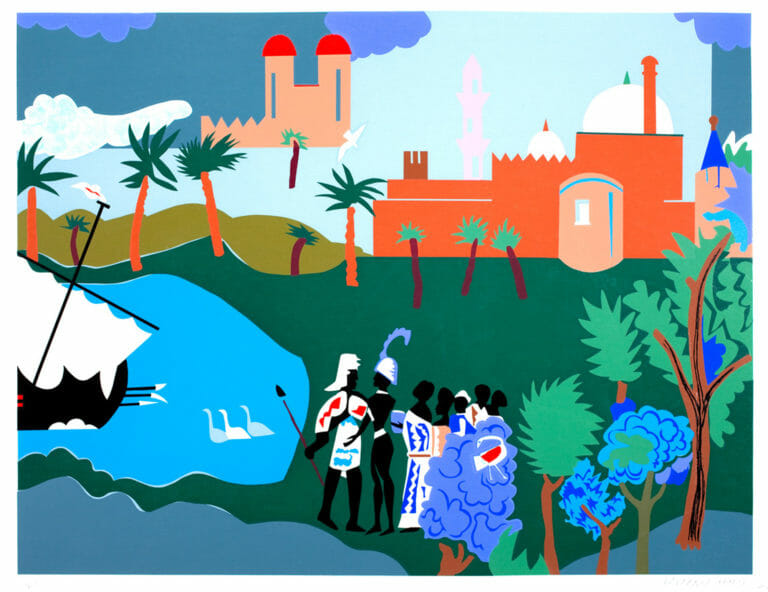 Romare Bearden – Odysseus Leaves Nausicaa
Romare Bearden – Odysseus Leaves Nausicaa
The Greek epic The Odyssey is filled with colorful tales of overcoming obstacles in the pursuit of an overriding goal. In the segment of the story shown here, Odysseus is saying goodbye to Nausicaa, daughter of King Alcinoos, who has rescued Odysseus and helped him obtain aid from her father to make his way back to his homeland.
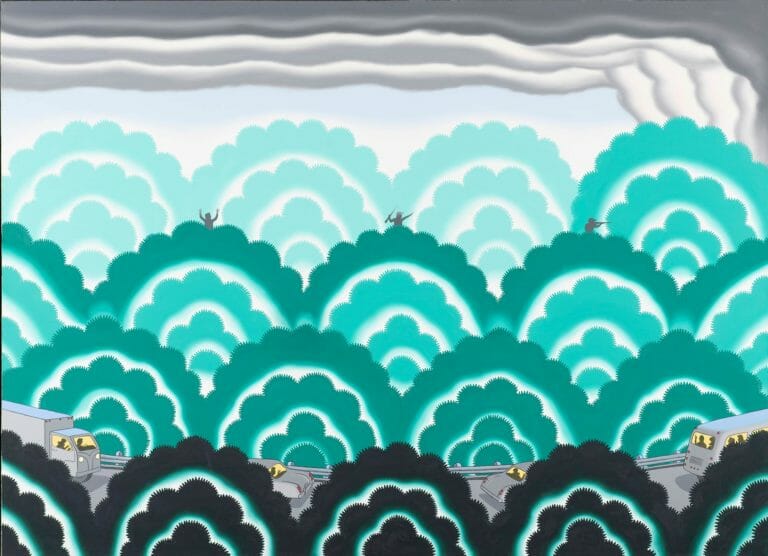 Roger Brown – Forest Fire
Roger Brown – Forest Fire
Roger Brown’s painting Forest Fire presents a mysterious scene. Cloud-like trees arranged in four neatly scalloped rows form a vast landscape of overlapping hills.
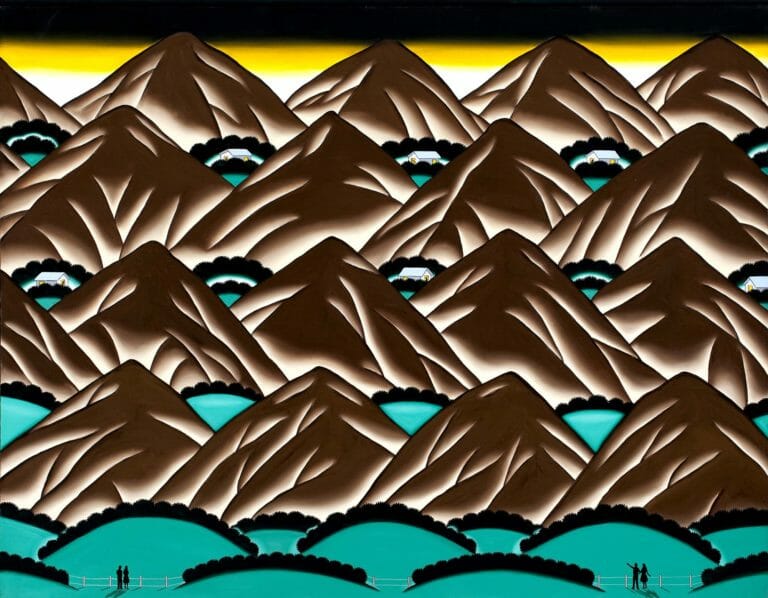 Roger Brown – Sudden Avalanche and Mountain Sites
Roger Brown – Sudden Avalanche and Mountain Sites
Two very different neighborhoods are depicted in Roger Brown’s oil paintings Sudden Avalanche and Mountain Sites, but in both scenes nature and humans are on a collision course. Silhouetted residents can be glimpsed through lighted windows, while outside in the natural world, people are having experiences that are key to unfolding stories.
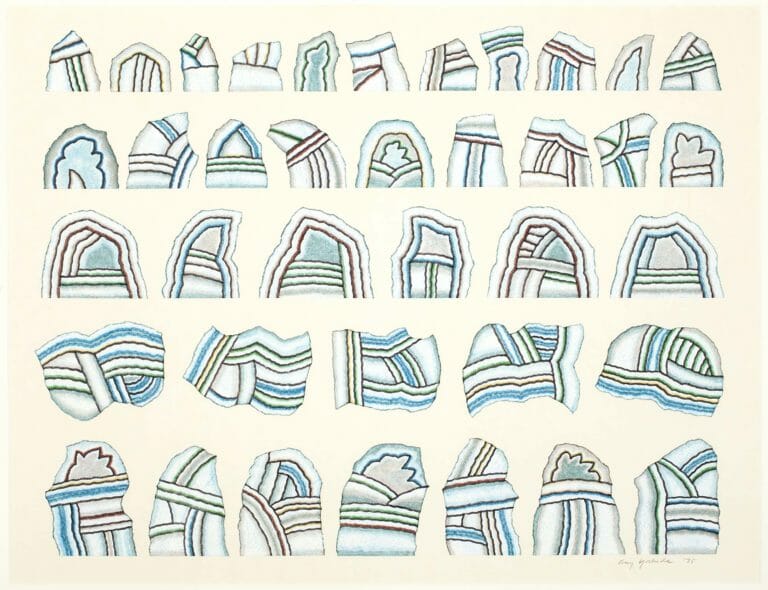 Ray Yoshida – Unreasonable Lineage
Ray Yoshida – Unreasonable Lineage
The torn paper fragments in this curious collage by Ray Yoshida appear to represent a collection of something. Thirty-eight irregularly shaped pieces of paper have been carefully arranged and pasted in five rows, loosely increasing in size and shifting form from tier to tier.
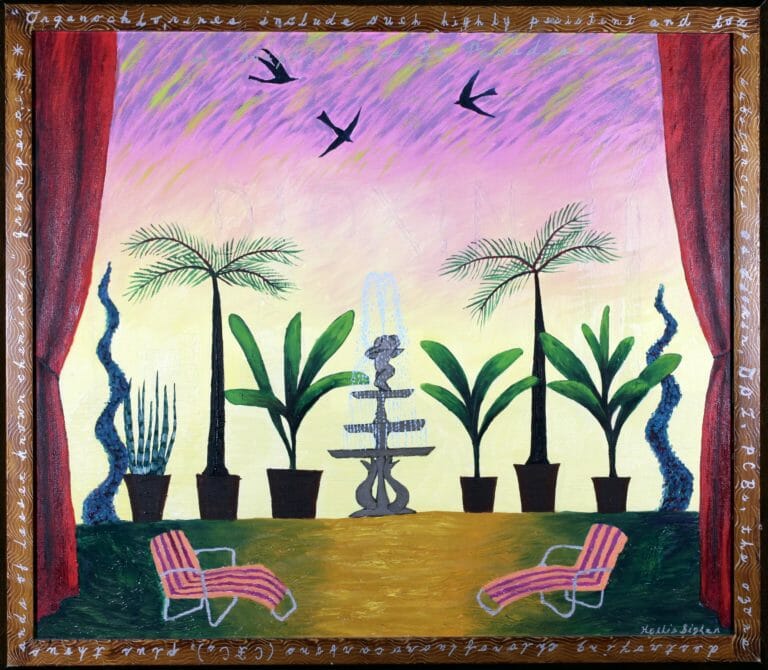 Hollis Sigler
Hollis Sigler
At first glance this colorful scene appears idyllic. Lawn chairs with matching fuchsia and orange stripes recline near a path of light. The lemon sky is turning orange and pink, with streaks of purple and lime.
 Ray Yoshida – AAIEEE!
Ray Yoshida – AAIEEE!
In this cut-paper collage by Ray Yoshida, over 180 individually excised pieces float against a flat pale-gray background. The pasted fragments appear to be evenly distributed across the large rectangular composition.
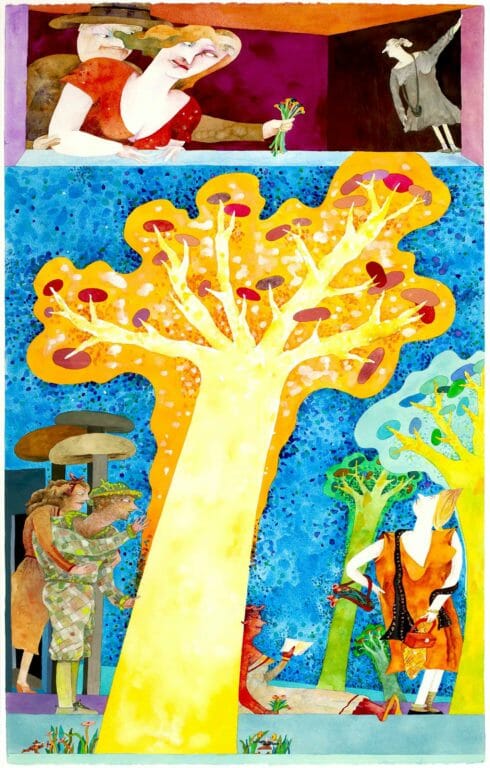 Gladys Nilsson
Gladys Nilsson
Some Other Tree and Sites Unscene display Gladys Nilsson’s delight in creating puzzling spaces crowded with interacting figures, and scenes where sizes of people and objects defy natural proportions.
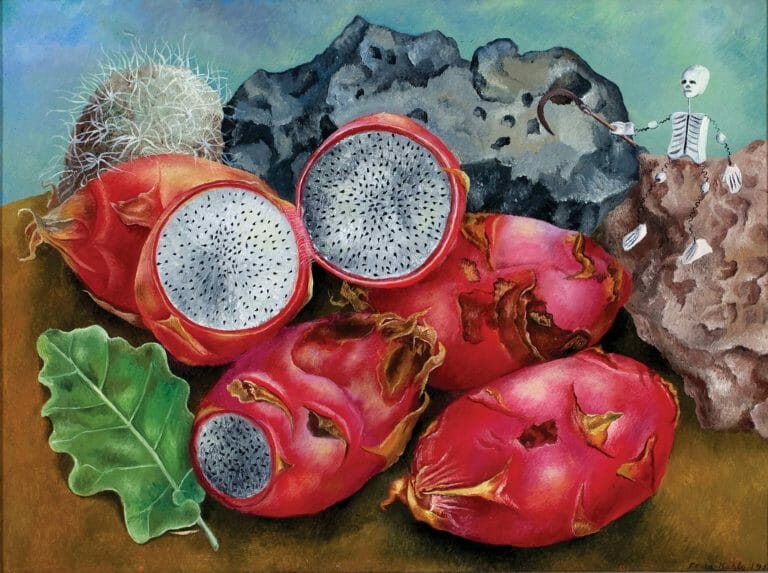 Frida Kahlo
Frida Kahlo
Frida Kahlo painted Still Life: Pitahayas in 1938 when she was thirty-one years old. It was painted with oil on aluminum, the traditional materials used in Mexico for religious altar paintings, known as ex-votos and retablos, which a supplicant would offer to a saint to acknowledge an answered prayer.
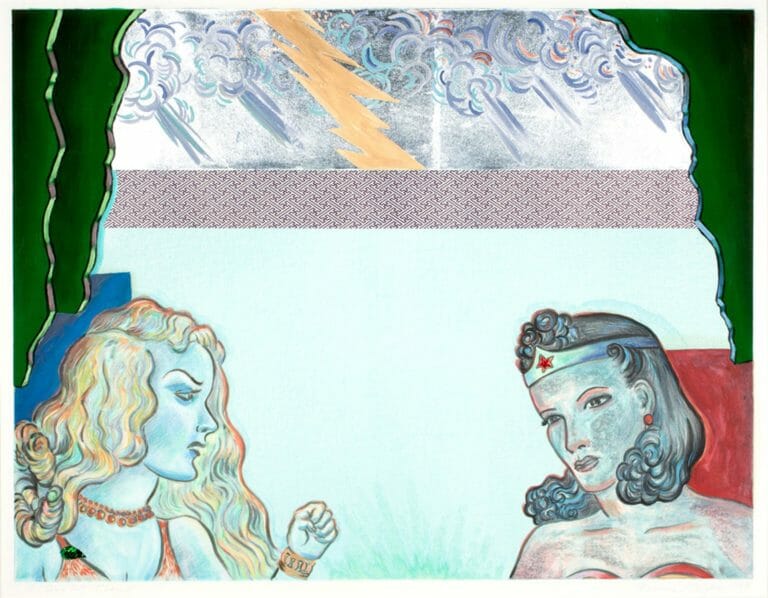 Frances Myers
Frances Myers
In A One Act Play, the familiar comic book hero Wonder Woman is confronted by another female character whose blonde hair, beaded necklace, and wrist cuff help identify her as Wonder Woman’s major adversary Queen Clea, ruler over parts of the underwater world of Atlantis.
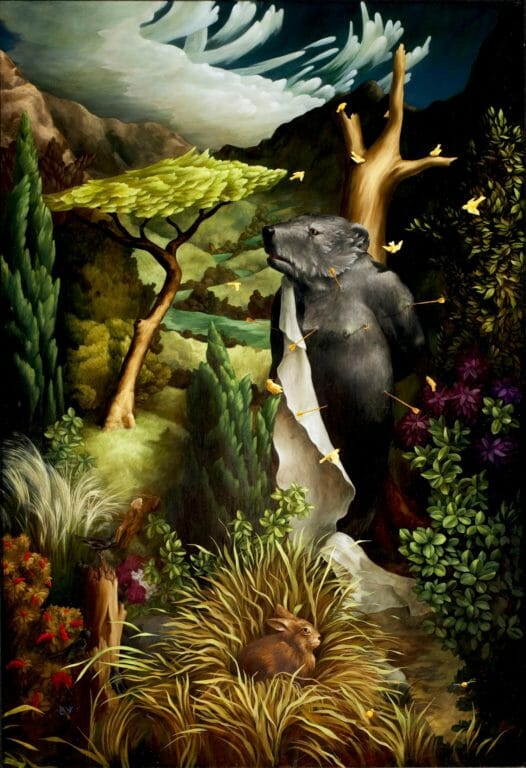 Erik Weisenburger
Erik Weisenburger
At once beautiful and mysterious, the paintings of Erik Weisenburger enchant viewers with their luscious color and intricate detail. Upon first glance, his painting Ursa Memoriam may recall traditional still-life or historical painting, but closer inspection reveals a contemporary voice that presents timeless subjects in new contexts.
 Ellen Lanyon
Ellen Lanyon
In Ellen Lanyon’s 1982─83 painting Chromos: Winter I, Autumn II, Spring III, Summer IV, four separate canvases function together as a single work of art that depicts the four seasons. Though Lanyon uses distinct colors and symbols to represent the individual seasons, she links the four separate paintings into a coherent whole by repeating the same motifs.
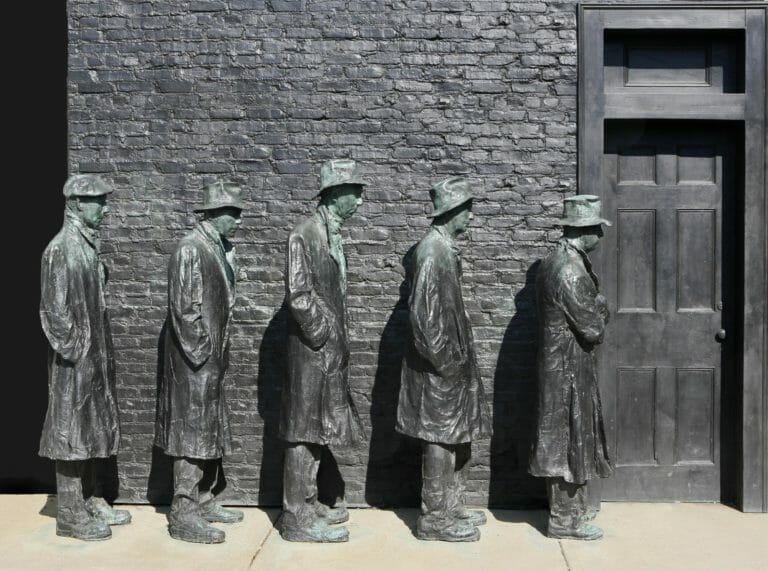 George Segal
George Segal
The large sculpture Depression Bread Line by George Segal portrays the experience of many urban Americans who suffered from hunger during the 1930s Great Depression. During this difficult period, which affected the whole world, economies faltered in both industrialized and non-industrialized countries.
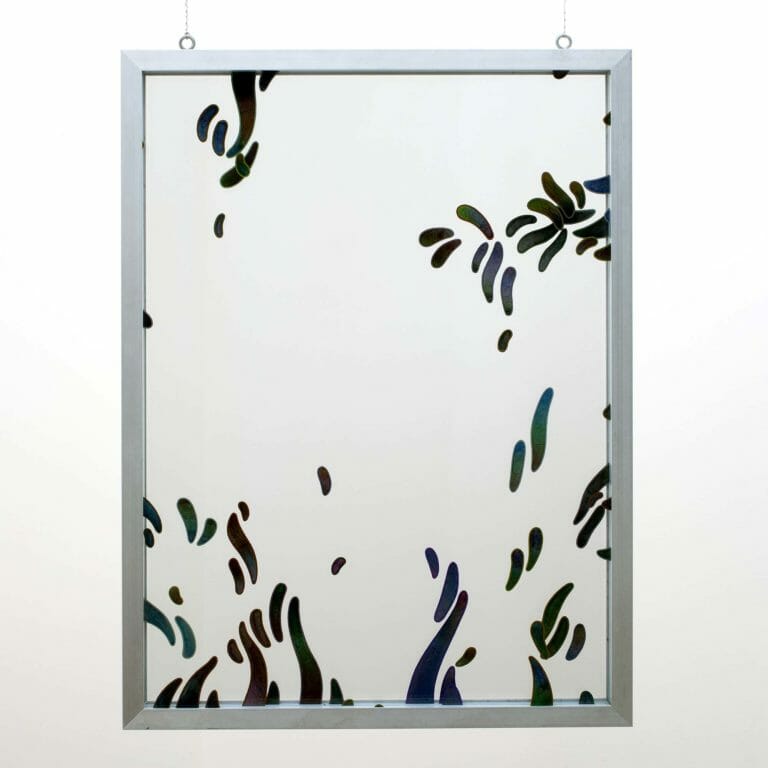 Edward Flood
Edward Flood
Ed Flood’s Aluminum Floater #2 is made from layers of Plexiglas in an aluminum frame. The artwork’s transparency causes its environment to be part of the composition. Organic shapes resembling seaweed, or perhaps amoebae or other microscopic life forms, seem to emerge from the edges of the frame and wriggle across the surface.
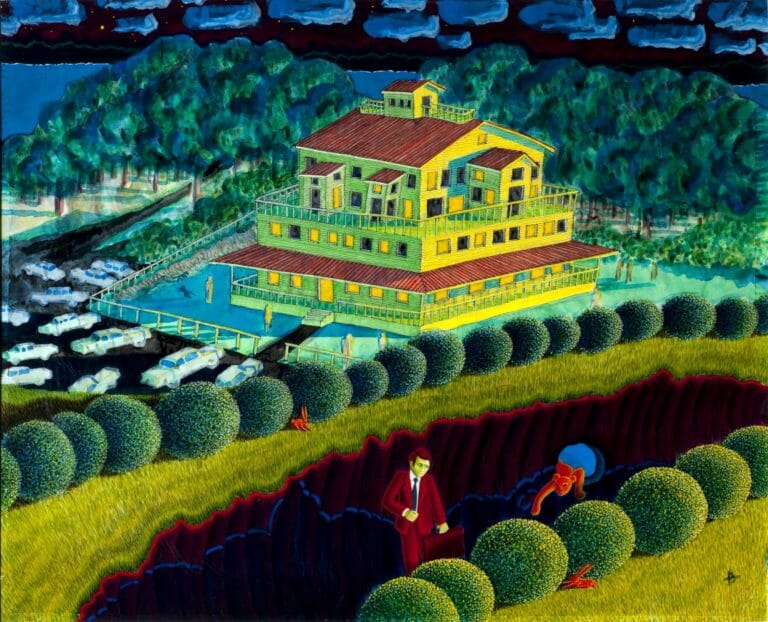 Duane Brissette
Duane Brissette
In Moonrise, an apparently festive occasion—people arriving at a brightly lit pavilion for a night of dancing—forms the backdrop for a potentially dangerous encounter. The action takes place in the bucolic surroundings of a lakeside resort.
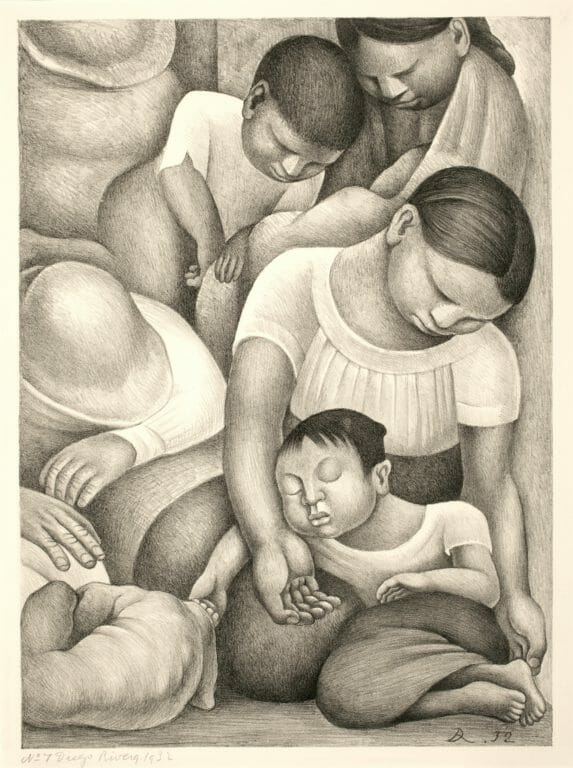 Diego Rivera
Diego Rivera
El sueño (La noche de los pobres), or Sleep (The night of the poor), is a part of a series of lithographs created by Diego Rivera that were published in New York by the Weyhe Gallery in 1932. El sueño portrays a group of Mexican campesinos, or rural peasantry, sleeping huddled together for warmth and support.
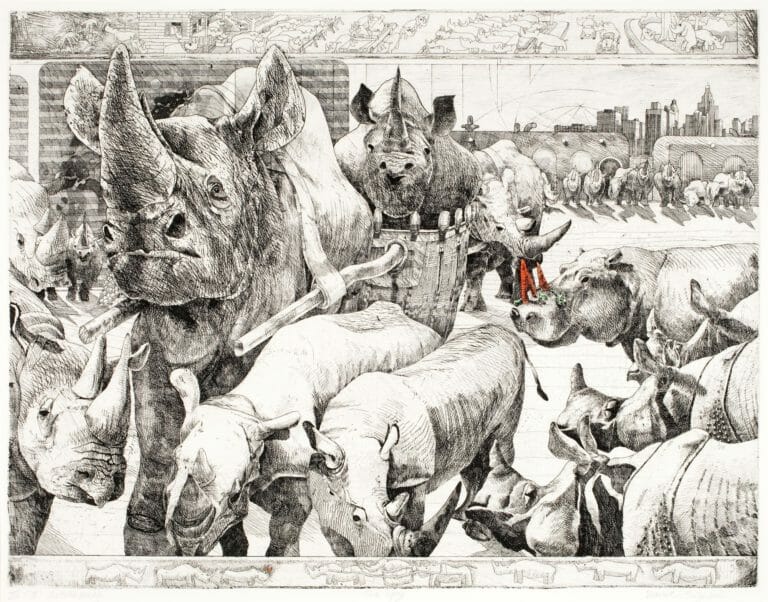 David Bigelow
David Bigelow
What a lot of rhinos! As many as twenty-one rhinoceros are standing in a plaza surrounded by adobe walls not far from a big city—settings that are very different from the grassland territories of wild rhinos.
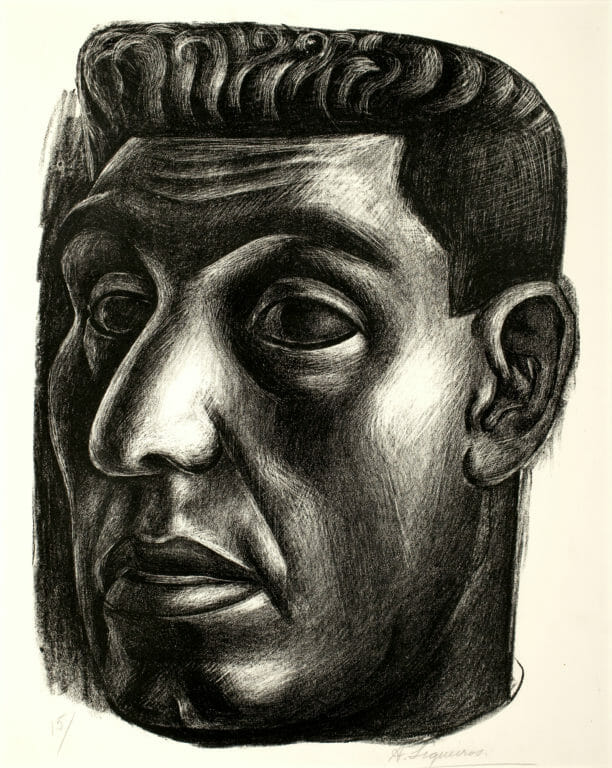 David Alfaro Siqueiros
David Alfaro Siqueiros
In his Portrait of Moisés Sáenz, artist David Alfaro Siqueiros has brought together several of his interests: modernist art styles that emphasized expressiveness; Revolutionary Mexico’s pride in its indigenous history; and post-Revolution governmental emphasis on universal education and literacy.
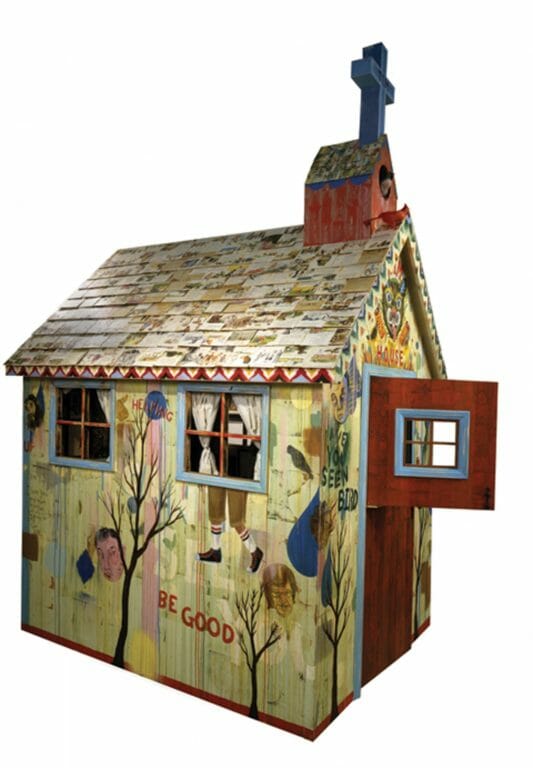 Clayton Brothers
Clayton Brothers
Tim House (In Green Pastures), the child-size sculpture by Rob and Christian Clayton, is a vibrantly painted wooden structure covered with words and images. The sculpture, with its cross bearing the name “Tim”, and its pointed roof and split door, is reminiscent of a clubhouse, a one-room schoolhouse, or a small church.
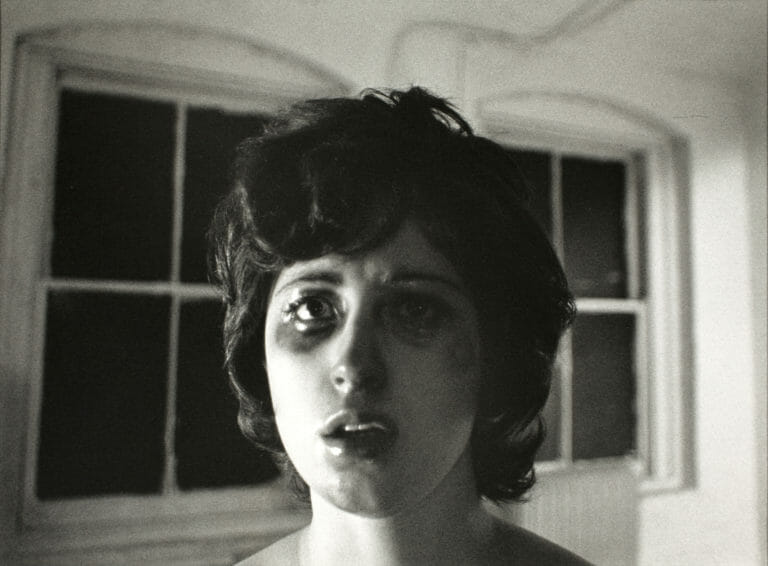 Cindy Sherman
Cindy Sherman
In Untitled Film Still #30, a distraught woman stares slack-jawed from within a dimly lit room. The setting is claustrophobic, with its dark windows, shallow depth of field, and blurred detail.
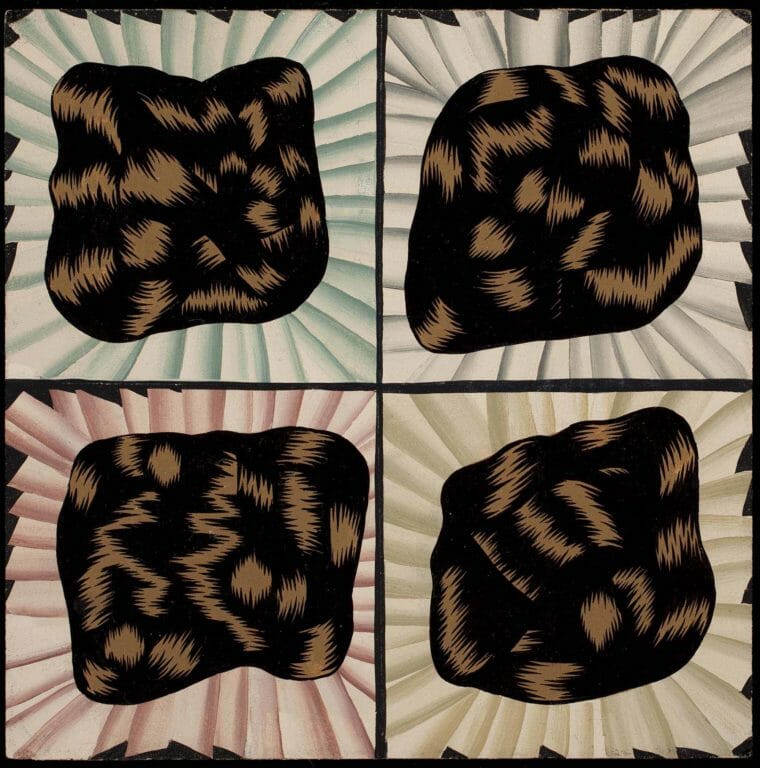 Christina Ramberg
Christina Ramberg
The flat picture plane of Christina Ramberg’s small acrylic painting, Untitled, is divided into a two-by-two grid of equilateral squares. Each quadrant foregrounds a shadowy, hard-edged form that appears to rest atop a delicate piece of pleated paper or ruffled fabric.
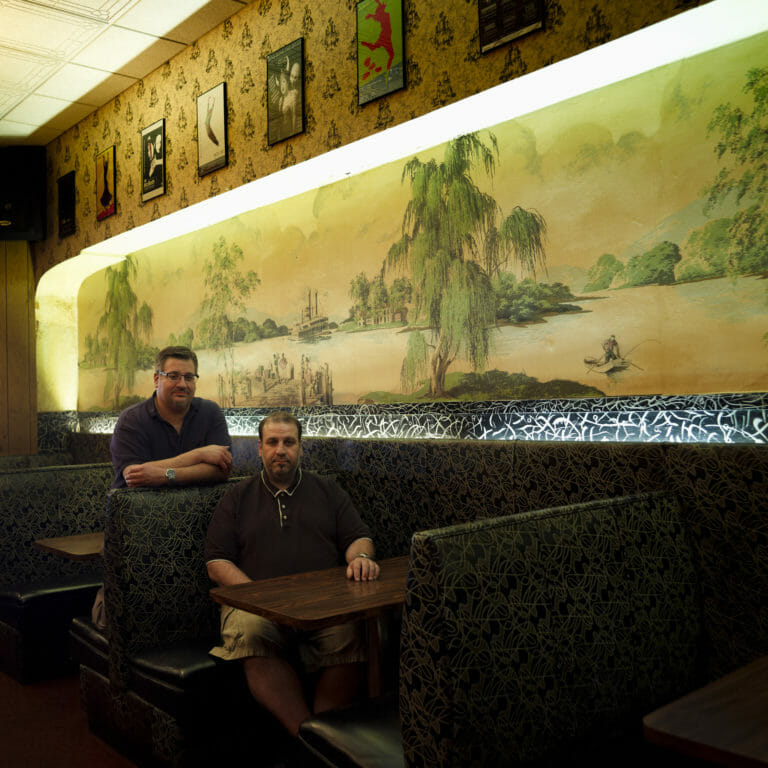 Carl Corey
Carl Corey
Nick’s Restaurant is a portrait of brothers Dino and Tom Christ in their long-established family restaurant. No customers or restaurant paraphernalia are in evidence, only the two owners.
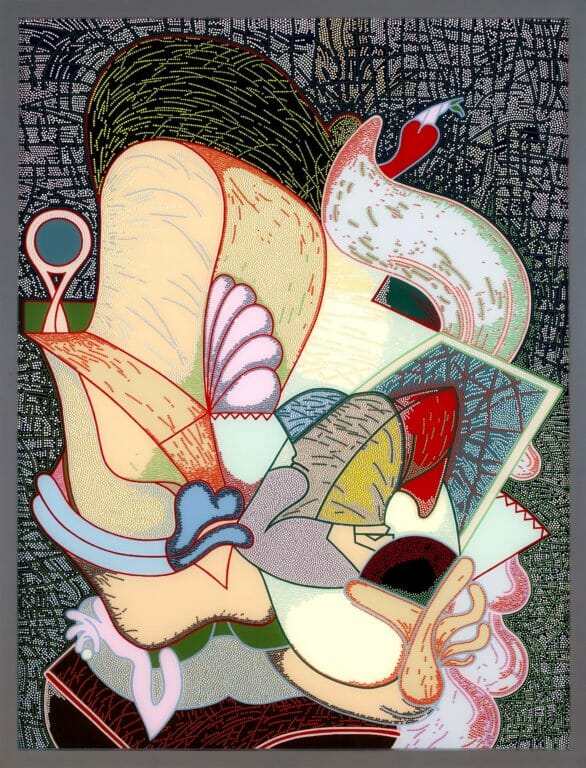 Barbara Rossi
Barbara Rossi
In Barbara Rossi’s 1974 painting on Plexiglas Eye Deal, a mass of globular forms appears to emerge upwards from beyond the bottom of the picture plane. Surreal, amorphous shapes twist and wind in an otherworldly configuration that is both figurative and abstract.
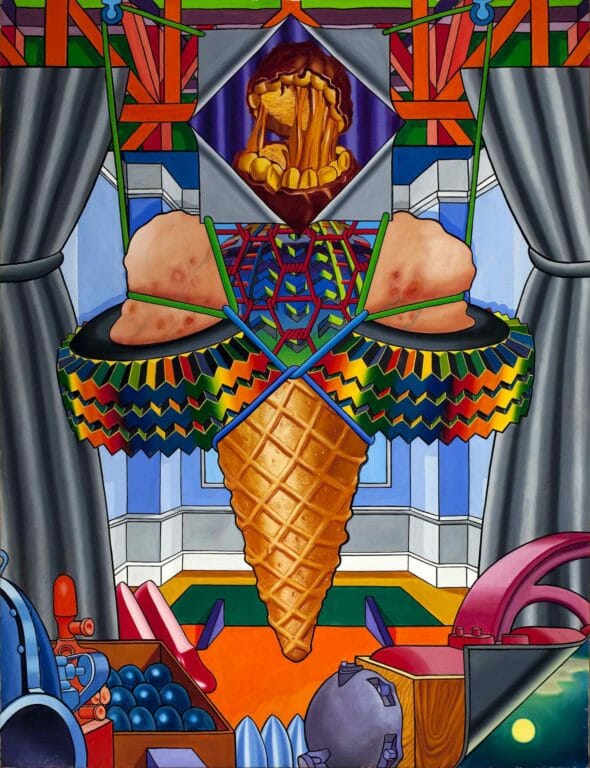 Art Green
Art Green
Regulatory Body presents a vibrant scene of brightly painted objects both familiar and puzzling. Red shoes, blue cannonballs, shiny gray missile heads, and peculiar machine parts are among the many items densely packed into a setting resembling a theater stage, where some of the objects function as an audience.
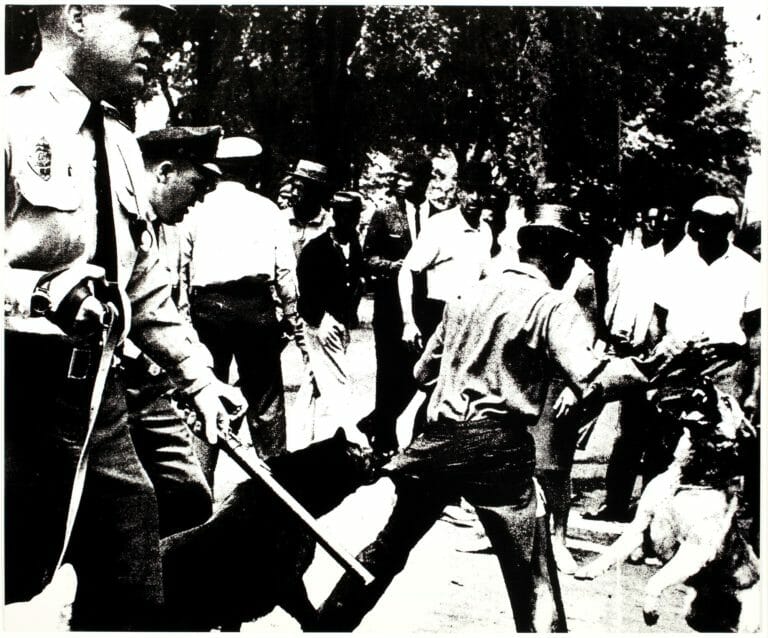 Andy Warhol
Andy Warhol
Andy Warhol’s photographic screenprint Birmingham Race Riot reveals a moment during a 1963 civil rights demonstration when white police officers and their dogs attacked black protesters.
